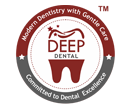YOUR THIRD DENTITION IMPLANTS!
Traditional treatment options for tooth replacement such as crowns, bridges and full or partial dentures, address the short-term cosmetic problem of missing teeth, but do nothing to stop bone loss. Crown & Bridge also requires that two or more healthy teeth be ground down to serve as abutments (posts) for a bridge, leaving them at a much greater risk for cavities and endodontic failure. If the original abutment teeth fail, more healthy teeth must be sacrificed to serve as posts, while you continue to lose bone beneath the bridge. With implants, however, the healthy teeth are left alone. Dental implants, like natural teeth, also transmit chewing forces to the jawbone, which reduces bone loss. This is why many leading dental organizations now recognize dental implants as the standard of care for tooth replacement.

Who is a candidate?
Dental implants can be placed in most adults who are in good to moderate health. They are not typically placed in adolescents until they have reached their full expected physical maturity. Certain uncontrolled medical conditions may decrease the effectiveness of implant treatment, so be sure to discuss your full medical history with your doctor before beginning treatment.
WHAT ARE IMPLANTS?
Modern dental implants are precision devices, available in several different designs to address your specific needs. The most common type is a titanium screw that is anchored into the jawbone where it serves as post for a custom-made tooth crown. Once the crown is in place you may not be able to tell it apart from your natural teeth.
I have only one missing tooth. Can I implants?
An implant may be used to replace almost any missing tooth, provided there is adequate bone at the site. If not, modern procedures can usually be performed to regenerate enough bone to safely place an implant.
The implant is placed in the bone below the gum tissue. A temporary abutment may be placed on the implant until the healing phase is complete. After healing, the abutment is attached to the implant. It will hold a custom-made crown that the dental laboratory will mold and match to your existing teeth. In the final step, the custom crown is cemented onto the abutment. The tooth has been replaced without disturbing the healthy teeth next to it and bone loss has been eliminated.
What if l have several missing teeth?
Implants can also be used to replace several teeth, eliminating the need to grind down healthy adjacent teeth to serve as posts for traditional Crown & Bridge therapy. The implants are placed in the bone below the gum tissue. Abutments may be placed on the implants until the healing phase is complete. Like single tooth replacement, temporary After healing, the abutments are attached to the implants. They will hold a custom-made bridge that the dental laboratory will mold and match to your existing teeth. In the final step, the custom bridge is cemented onto the abutments. The teeth have been replaced without disturbing the healthy teeth next to them, and bone loss has been halted.
What if all my teeth are missing?
Implant supported prosthesis (removable)
The implants are positioned just below the gum tissue and given time to fuse with the bone. Temporary abutments may be placed on the implants until the healing phase is complete. Your existing denture can be modified so that it may be worn without disturbing the implants during the healing process. You will be fitted for a custom-made bar that attaches to the implants to support a new denture. Your existing denture may be modified to be worn during this period. The new denture will have attachments which snap or clip it into place. Your new teeth are firmly supported by the jaw, stimulating it and halting bone loss. You will be able to remove the denture easily for cleaning.
Implant-supported prosthesis (Fixed)
If all your lower or upper teeth are missing, a permanent bridge may be attached directly to the implants. The number of implants is determined by the specific requirements of each case. The implants are positioned just below the gum tissue and given time to fuse with the bone. Temporary abutments may be placed on the implants until the healing phase is complete. Your existing denture may be modified so that it can be worn without disturbing the implants during the healing process You will be fitted for a custom bridge that screws directly into the implants. The screw holes will be covered after insertion. Your new teeth are firmly supported by the jaw, stimulating it and halting bone loss. Your dentist will be able to remove the prosthesis when necessary for cleaning and maintenance.

